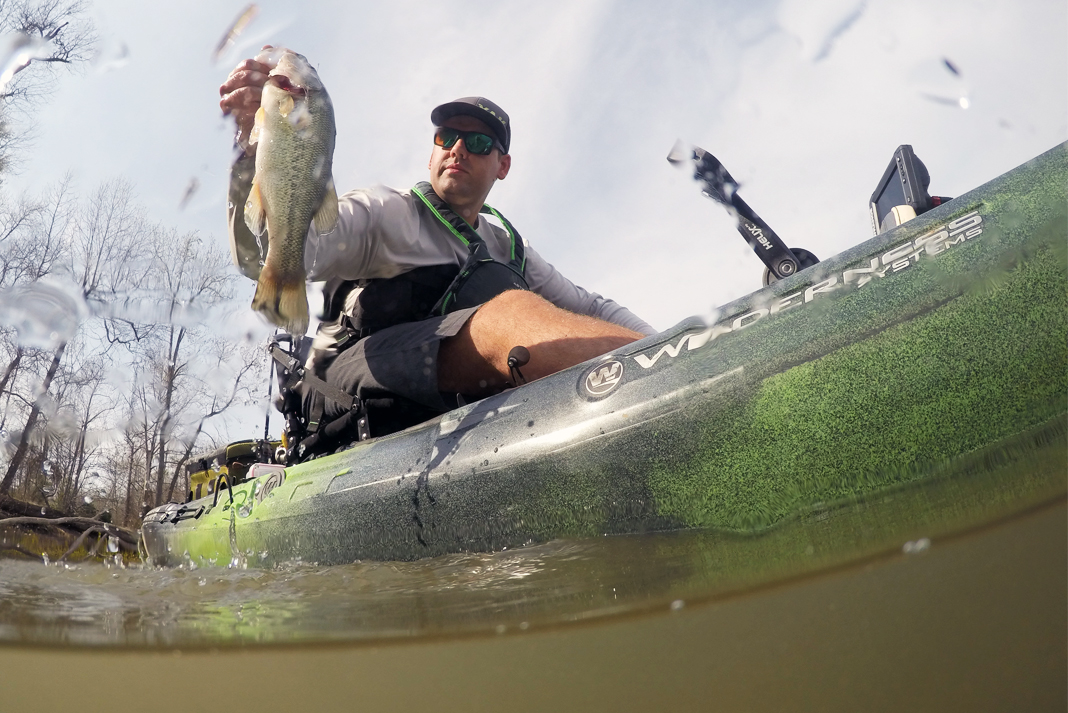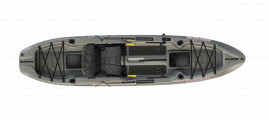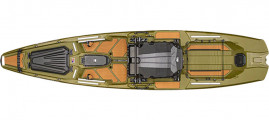Twelve-foot fishing kayaks are like the porridge that’s just right. Not too long, not too short. They provide good compromises between maneuverability and tracking, and between speed and stability. Many kayak anglers are well aware of the benefits of 12-foot fishing kayaks, and so are manufacturers. This is why 12-foot fishing kayaks are some of the most popular types on the market.
Twelve-foot fishing kayaks are available in both sit-inside and sit-on-top designs, though sit-on-top are the most common.
A sit-inside kayak is a fishing kayak in which paddlers slide their legs into an interior cockpit within the hollow hull of the kayak, and may also wear a sprayskirt sealing the torso to the cockpit.
A sit-on-top kayak is one in which the paddler sits on a seat on the deck of a flat-topped kayak. The seat may take the form of a sitting area molded into the deck or an elevated seat fixed above the deck. Sit-on-top kayaks are very popular for kayak anglers owing to the mobility they provide the paddler. The exposed design means paddlers can reach to a tackle box, swing a leg over the side or even stand up to cast. Sit-on-top fishing kayaks also lend themselves to the use of wider, more stable hulls and the ability to outfit with a range of fishing accessories.
Twelve-foot fishing kayaks are also available in a range of propulsion options. Some are paddled the old-fashioned way. Others employ a fin or propeller system that’s powered by foot pedal drives. In recent years fishing kayaks have also come to accept electric trolling motors, for fully motorized kayaking.
The field of available 12-footers is vast. This article will help you find the best 12-foot kayak for your kayak angling plans.
Top picks: Best 12-foot fishing kayaks for 2025
The following 12-foot fishing kayaks have received the highest star ratings by reviewers in our Paddling Buyer’s Guide. See and review all 12-foot fishing kayaks here.
Best 12 Foot Fishing Kayaks
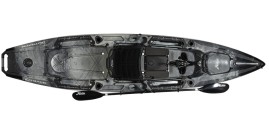
Mirage Outback

A.T.A.K. 120 Fishing Kayak
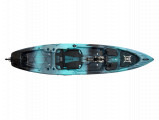
Pescador Pilot 12.0
-first_product_boats.jpg)
BKC TK122 Angler Tandem Coastal Cruiser Kayak

133X Tournament Sit-On-Top Kayak with Yak-Power
Shop for 12-foot fishing kayaks
Within our Paddling Buyer’s Guide we’ve categorized different styles of 12-foot fishing kayaks. Here you will find the 12-foot fishing kayak models offered by popular brands, both sit-inside and sit-on-top. Every kayak model included in our buyer’s guide includes specs, prices, reviews and some common places where these kayaks are available.
Shop by type
Shop by brand
Bonafide 12-foot fishing kayaks
Brooklyn Kayak Company 12-foot fishing kayaks
Eddyline 12-foot fishing kayaks
Feelfree 12-foot fishing kayaks
Hobie 12-foot fishing kayaks
Lifetime 12-foot fishing kayaks
Native Watercraft 12-foot fishing kayaks
Ocean 12-foot fishing kayaks
Old Town 12-foot fishing kayaks
Otto Vallinga 12-foot fishing kayaks
Pelican 12-foot fishing kayaks
Perception 12-foot fishing kayaks
Sea Eagle 12-foot fishing kayaks
SKANU 12-foot fishing kayaks
Sun Dolphin 12-foot fishing kayaks
Wilderness Systems 12-foot fishing kayaks
Shop by store
Shop by price
Shopping for a used 12-foot fishing kayak?
Buying a used 12-foot fishing kayak can be just as tough as shopping for a used car. Hours, even days can be spent poring over sites like Craigslist, Kijiji or Facebook Marketplace trying to score the ultimate deal. Before you purchase a used 12-foot fishing kayak, here are a few thoughts to keep in mind.
Does the price of a used kayak make sense compared to buying new?
Depending on which brand of fishing kayak you find there can be a wide price range for the sticker price of a new boat. Do your brand research and see how much of a deal you are actually getting for the pre-loved boat.
If you are scooping up an expensive kayak for under $1,000, that’s great. But if you are looking at models which only cost a few hundred dollars when bought new, consider if the beat-up boat that’s growing mold under the seller’s porch is actually a better deal than a new purchase.
Be skeptical of owner-installed modifications
Souping up your rig is a common kayak angler pastime. The idea of going overboard doesn’t really exist for kayak anglers, at least not when it comes to adding additional gear mounts or installing a trolling motor mount via two-by-fours.
Making modifications to your fishing kayak is fun but, when purchasing a used 12-foot fishing kayak, be skeptical of the work others have done to the kayak. Look for cracks and gaps around any bolts and holes which have been added. These will leak, and be points of failure on a kayak. Self-made modifications aren’t exactly manufacturer approved, so unless you’ve found the dream rig you could never put together on your own, it’s better to have a kayak on which you can make your own modifications.
Will this kayak actually work for your needs?
There are a lot of 12-foot fishing kayak models on the market. Some are good, and some are terrible. You want to know a kayak has the speed, tracking performance and (perhaps most of all) stability you will be comfortable with. The only way to know for sure if a 12-foot fishing kayak is the best for you is to get it out on the water.
For more tips on what to look for when selecting a used fishing kayak, read our article How To Buy A Used Fishing Kayak.
12-foot fishing kayak buying advice
Twelve feet is one of the most popular sizes of fishing kayak. Twelve-foot kayaks are valued for being a reasonable compromise that manages to satisfy the competing needs for both cargo space and speed; and maneuverability and tracking. Twelve-foot fishing kayaks also generally provide enough width to be sufficiently stable for most situations.
When buying a 12-foot fishing kayak there are a few factors you will need to decide on.
Sit-on-top vs sit-inside
Are you seeking a sit-inside or sit-on-top fishing kayak?
A sit-on-top fishing kayak is the most popular for kayak angling. A sit-on-top kayak is like having an open workbench. Almost everything, including the seating area, is laid out on the deck of the kayak. The seat being on top of the flat deck is the main feature of a sit-on-top kayak. This gives the paddler access to much of the kayak deck space while underway. You can reach a tackle box, swing a leg over the side to land your fish and, on models with sufficient stability, you may even stand up to cast or gain a better view.
Sit-inside kayaks are another type of fishing kayak, and are a bit of an old-school choice. With a sit-inside kayak the paddler sits within the interior of the kayak. It’s a nice way to stay out of the elements, but decreases mobility for an angler. Sit-inside kayaks usually have hatches to store gear internally, this can be helpful if you are spending more time paddling than going through your lures, but also limits access to your tackle.
One of the biggest downsides to a sit-inside kayak is in the consequences of a capsize. When a sit-inside kayak capsizes the open cavity of the kayak fills with water. This means you have to get to shore and empty the kayak before you can re-enter. With a sit-on-top kayak, if you fall over or the kayak capsizes, you can just climb back on.
Propulsion
Another feature you will want to take into account for your 12-foot fishing kayak is your mode of propulsion.
Fishing kayaks that are 12 feet long are available in a few propulsion options: paddle, pedal-propelled and motorized.
Traditional paddle kayaks get where they are going the old-fashioned way of finishing one stroke after another and repeating.
A paddle kayak seems like a proven option, but one of the downsides to a paddle-only kayak is the need to use your hands for multiple tasks while fishing. It can quickly get frustrating to try to multitask with your hands. The other types that leave your hands free are an obvious choice, but they are significantly more expensive. Are pedal- and motor-powered kayaks worth it? They can be. There are huge advantages if your main focus is fishing, you have the room in your budget and you don’t mind hauling the additional weight of a pedal drive or trolling motor.
Both give the paddler a hands-free option, and keep you on the water longer through the use of leg muscles or a marine battery.
Pedal drives are more common than pre-installed trolling motors. They keep the experience simpler and human-propelled (and so remain a great way to exercise), and require less overhead and maintenance than a trolling motor.
If you decide on either a pedal drive or trolling motor, one thing is certain: once you’ve known the freedom of hands-free kayak angling you may never go back to the days of juggling casts between paddle strokes to keep you from being blown into overhanging branches along an undercut bank.
Hull type
The other major design element you may need to consider is the hull type and stability of the kayak. In simplified terms, some of the most common fishing kayak hull types are flat-bottomed, rounded, and pontoon-hulled.
The two types of stability for a boat are initial stability and secondary stability. Initial stability is how stable the boat feels while flat on the water. Secondary stability is the kayak’s ability to tilt and stay on an edge without capsizing. Secondary stability is important for a kayak especially in conditions where waves are expected. The secondary stability allows the waves to roll under the kayak instead of flipping the kayak.
Simply put, for any given length of boat, the more surface area of the hull making contact with the waterline the more stable it will be, whether sitting flat or tilted. Generally, a flat hull has more initial stability, and a round hull provides better secondary stability.
Most modern 12-foot fishing kayak models combine various hull shapes to gain various advantages.
Pontoon hulls have a W-shape and are some of the most stable overall, though they generally plow slowly through the water. Pontoon shapes provide a great hull shape for a wide kayak with a standing platform within the cockpit.
When you are buying a fishing kayak, inspect the hulls of each to take note of the shape.
Ultimately, the best way to know which will be the best 12-foot kayak for fishing is to paddle as many as possible. If possible, take a test paddle before purchasing any kayak. Local specialty paddling retailers can be a great resource to learn which kayaks will work best for you and your waterways.
Have more questions? We’ll address some of the most common questions on 12-foot fishing kayaks here.
-
10 vs 12 fishing kayak
When deciding between a 10-foot and 12-foot fishing kayak, consider the type of paddling you will be doing. A 12-foot fishing kayak will be faster than a 10-foot kayak. A 12-foot fishing kayak will also provide more surface area, and will generally be more stable. The increased length of the hull will also tend to be faster and provide better tracking for the kayak to travel in a straight line.
If you are on the fence between a 10-foot and 12-foot fishing kayak, consider each kayak’s maximum capacity, and the weight of the kayak itself for transporting. A 12-foot kayak will usually be better for larger paddlers, but the kayak itself will also be heavier.
-
Lightest 12-foot fishing kayak
If you are looking for the absolute lightest 12-foot fishing kayak this would most likely be an inflatable model. However inflatables do not have the durability and rigidity provided by a kayak made from hard plastic. The lightest, hard-shell plastic kayaks are generally those built by thermoforming. Two examples of brands who use thermoforming are Pelican and Delta.
12 ft fishing kayak reviews
In our fishing kayak reviews we’ve picked apart the most popular 12-foot fishing kayaks available. Here you’ll find an in-depth look at each 12-foot fishing kayak, including everything from background on the brand, to specifications and how they feel on the water.
- Fishing Kayak Review: SeaStream Angler 120 PD
- Fishing Kayak Review: Ascend 12t
- Fishing Kayak Review: Sun Dolphin Boss 12 SS
- Fishing Kayak Review: Ascend 128t
- Fishing Kayak Review: Perception Pescador 12
- Hybrid Fishing SUP Review: Vibe Cubera 120



